Share this
How to Persuade Employers to Accept Day 1 CPT? (With 2 Templates)
by Abby on Oct 12, 2023
Using Day 1 CPT for internship/employment can be a viable option, but it often involves a fair amount of communication with your employer and HR. Many employers may not fully understand Day 1 CPT or have misconceptions about its legality. Today, we'll provide a template for communicating with your supervisor and HR about working with Day 1 CPT.
1. Introduction:
Working with Day 1 CPT typically falls into two scenarios:
-
Extending your work status with your current employer using CPT.
-
Example Scenario: Your OPT (Optional Practical Training) under your F1 student visa expires, and you wish to continue working for your current employer by enrolling in a Day 1 CPT program.
-
-
Transitioning to a new job with a different employer using CPT.
-
An example scenario is when you want to switch jobs and use CPT for a new employer after previously using CPT for your former employer.
-

2. Scenario 1: Extending your work status with Day 1 CPT
We recommend initiating a discussion with your employer and HR 6 months before your OPT expires and you have no alternative visa options, such as H1B or L1.
You can bring up the following points in your communication with your manager during your weekly one-on-one meetings or in emails with HR:
-
Mention that you are facing an issue with your work visa, which is nearing expiration, and need the company's assistance obtaining a new visa.
-
Explain that through your research, you have identified the option of enrolling in a Day 1 CPT program to continue working.
-
This section briefly overviews Day 1 CPT and why it allows for full-time employment. For more information, refer to USCIS and our website.
-
Emphasize that working with CPT is entirely legal and compliant. Introducing the Day 1 CPT program allows you to continue learning and strengthen relevant skills. At the same time, it is a professional program that will permit you to obtain CPT Work Authorization during your study period and to keep working. You can start working from day one of the program, and the classes are typically scheduled during evenings and weekends, ensuring that they won't interfere with your work hours.
-
Highlight the benefits to the company in supporting your use of Day 1 CPT for continued employment.
-
Outline what steps the company needs to take to support your use of Day 1 CPT.
-
Attach a list of Day 1 CPT schools you've researched for reference.
You may use the template provided below:
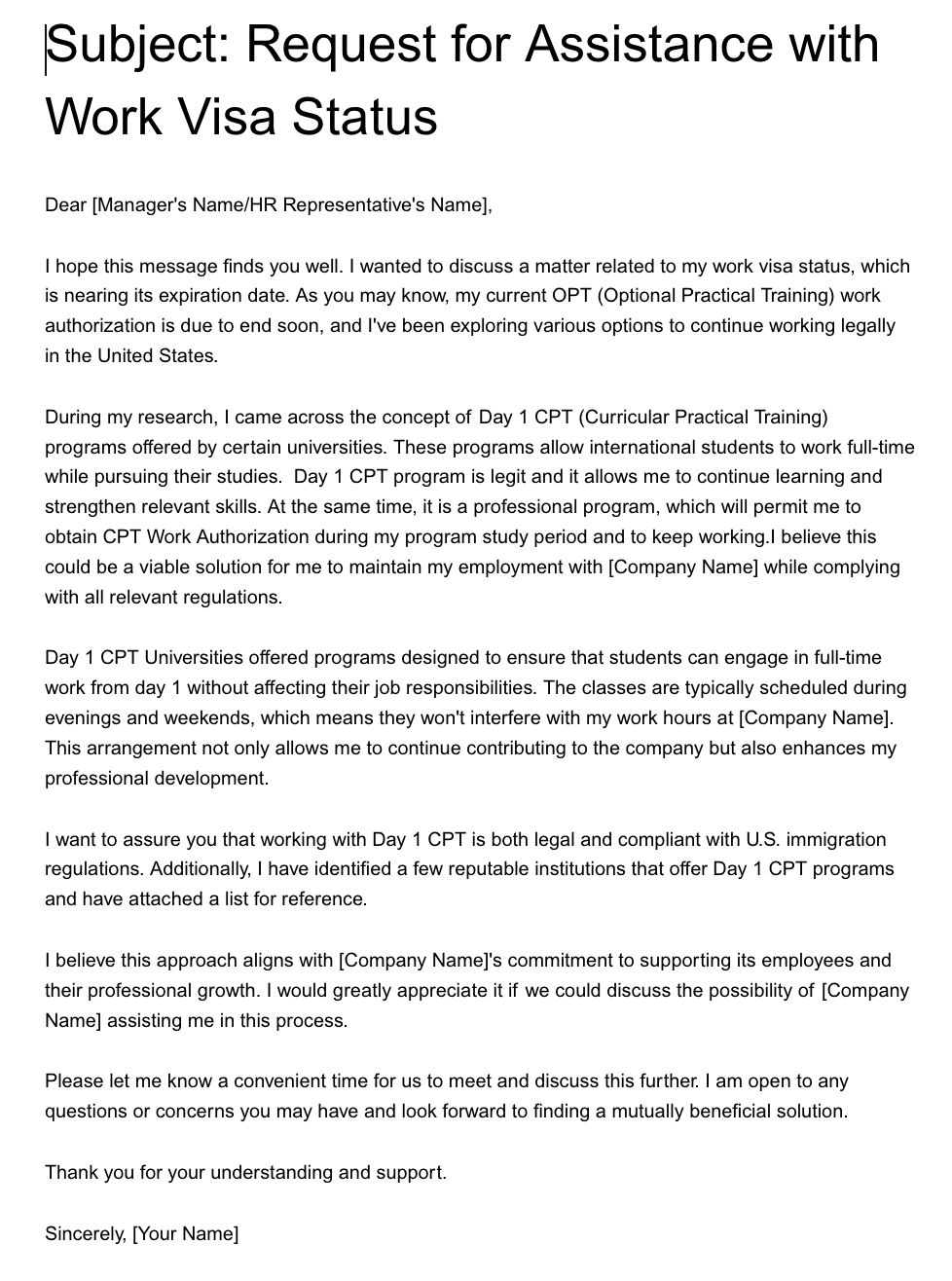
Template 1
Contact us to download the editable version +
Feel free to adapt and use the template according to your situation and communication preferences. Open and honest communication with your employer and HR is crucial when considering Day 1 CPT as an option for your continued employment or career transition.
3. Scenario 2: Switching Jobs with Day 1 CPT
Using Day 1 CPT to find a new job is a different scenario than using CPT to continue your previous work. It's more complicated and requires more communication with employers.
Step 1
Firstly, which companies support Day 1 CPT employment? We've compiled a list of Day-1 CPT-friendly employers, which can be accessed here, including whether they support CPT work authorization, require a CPT agreement to be signed, and the positions that have historically supported Day-1 CPT hires. This list encompasses companies of various sizes and industries so you can have a better idea when applying for jobs.
In general, many large tech companies are more inclined to support previous employees who didn't secure an H1B visa and want to transition to a CPT visa. However, their acceptance of new hires with CPT status is somewhat limited. On the other hand, some financial institutions tend to have more favorable policies for new hire CPT candidates. Smaller to mid-sized companies often handle CPT policies on a case-by-case basis, allowing for more room for negotiation based on individual performance.
Step 2
Secondly, should you disclose your CPT status to HR when interviewing for jobs, and how should you do it?
Hiding your work status is definitely not advisable. Concealing your visa status issues can lead to significant problems during your onboarding process. Wildfire recommends that you address CPT-related issues with HR during the interview stage. However, there are some nuances to when and how to disclose your visa status.
For smaller to mid-sized companies without a clearly defined CPT policy, you don't have to volunteer the information right away if HR doesn't proactively inquire about the details. Typically, recruiters will ask about your current status during the initial HR phone screen. You can now mention that you're on an F1 visa and that your work authorization has several years remaining (indicating how long you have until graduation). If HR further asks whether you are on OPT or CPT, you can explain that you are enrolled in a master's or doctoral program that supports using CPT authorization to work for an employer.
Smaller to mid-sized companies often have relatively flexible visa policies and are more interested in your background, skills, and how well you match the job. Hiring managers may have a significant influence in such cases. If HR doesn't ask about your immigration status in the initial rounds, you can consider bringing it up after interviewing the hiring manager. Of course, if you're in a hurry to find a job and don't want to waste time navigating these discussions, it's also acceptable to clearly state your needs from the beginning and cut your losses early with employers who don't support CPT.
If the company you interview with asks you to explain your CPT status, you can refer to the email template below:
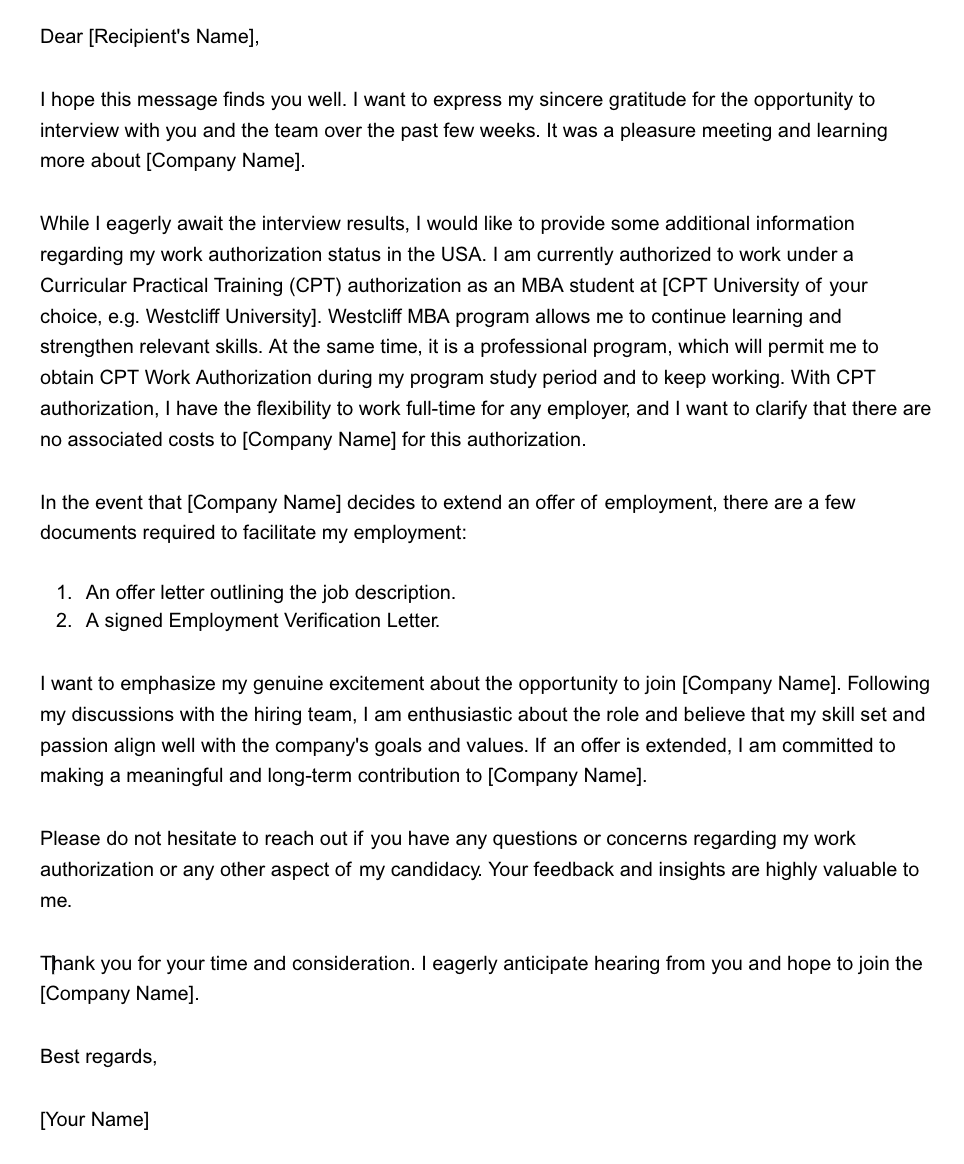
Template 1
Contact us to download the editable version +
In general, when employers evaluate candidates, the most crucial factor is whether the candidate can provide value to the company over the next 3-5 years. When employers doubt your CPT status during the hiring process, you must emphasize your ability and willingness to contribute long-term value to the company.
4. Common Rejection Reasons and Solutions
Some employers are hesitant or unwilling to hire employees under Day 1 CPT, and there are a few reasons for this hesitation:
-
Lack of Awareness: Some employers may not be familiar with Day 1 CPT or how it operates. This unfamiliarity can make them hesitant to move forward with such candidates.
-
Concerns about Compliance: U.S. immigration laws and regulations are complex, and employers often worry about inadvertently violating them. Hiring someone on Day 1 CPT, especially without a clear understanding of it, can seem risky.
-
Perception of Temporary Employment: Employers might be looking for longer-term employees, and Day 1 CPT might be perceived as a short-term solution. There's also a misconception that students on CPT might not be as committed to the job as others.
-
Potential Scrutiny: In recent years, the U.S. government has been increasingly scrutinizing the use and possible abuse of the CPT program. Employers may fear hiring someone on Day 1 CPT might attract unwanted attention from immigration authorities.
-
Complexity in Transition: Employers might anticipate complications in the future when transitioning an employee from CPT to another type of work authorization (such as H-1B).
-
Concerns About Authenticity of Universities: Certain universities offering Day 1 CPT have been reported as not obeying US laws. Hiring from such universities could lead to legal and compliance issues for employers.
To better communicate with potential employers and alleviate their concerns:
-
Educate the Employer: Be prepared to explain what Day 1 CPT is, how it works, and its benefits. You can provide official documentation or website links from U.S. government sources that explain CPT.
-
Assure Compliance: Let the employer know that you've ensured your Day 1 CPT complies with all regulations and that you're attending a legitimate institution.
-
Demonstrate Commitment: Make it clear that you're serious about the job and see it as more than just a temporary stepping stone. Discuss your long-term career goals and how the position aligns with them.
-
Highlight Your Skills: Shift the focus from your work authorization to your skills, qualifications, and what you bring. Employers are primarily looking for value and fit.
-
Seek Legal Counsel: If possible, and especially for more prominent employers or roles, you might consider having an immigration attorney explain the legality and benefits of Day 1 CPT to the employer.
-
Prepare for H-1B or Other Options: If you plan to transition to another visa type, like H-1B, in the future, let the employer know. This might ease concerns about the longevity of your stay with the company.
Remember, the key is to be proactive, informed, and prepared to answer any questions or concerns an employer might have.

Conclusion
This blog post summarizes two scenarios for persuading your employers to accept Day 1 CPT and provides two ready-to-use email communication templates. If you have more questions about communicating strategically or general questions regarding Day 1 CPT, feel free to contact us. We offer customized, FREE consultations!
Share this
- Day 1 CPT (32)
- H1B (24)
- Day 1 CPT Universities (15)
- H1B Lottery (11)
- CPT (6)
- Green card (5)
- University Application (4)
- F1 (3)
- F1 Status (3)
- International Students (3)
- USCIS (3)
- Concordia University Texas (2)
- F1 Reinstatement (2)
- H1B Layoff (2)
- H1B Status (2)
- OPT (2)
- STEM OPT (2)
- Westcliff University (2)
- change of status (2)
- Bay Atlantic University (1)
- English Proficiency (1)
- Goldey-Beacom College (1)
- Green Card Application (1)
- H4 EAD (1)
- H4 Visa (1)
- Humphreys University (1)
- Immigration (1)
- International Student Travel (1)
- Jobs (1)
- L1 (1)
- Layoff (1)
- McDaniel University (1)
- O1 (1)
- Saint Peter's University (1)
- Scholarships (1)
- Tax (1)
- October 2025 (1)
- September 2025 (3)
- August 2025 (2)
- June 2025 (1)
- May 2025 (2)
- March 2025 (2)
- November 2024 (2)
- October 2024 (4)
- September 2024 (3)
- August 2024 (3)
- July 2024 (2)
- June 2024 (7)
- May 2024 (3)
- April 2024 (4)
- March 2024 (3)
- February 2024 (5)
- January 2024 (1)
- October 2023 (3)
- September 2023 (6)
- August 2023 (10)
- July 2023 (3)
- June 2023 (4)
- May 2023 (1)
- April 2023 (1)
- February 2023 (1)
- November 2022 (1)
- October 2022 (3)
- September 2022 (1)
- August 2022 (1)
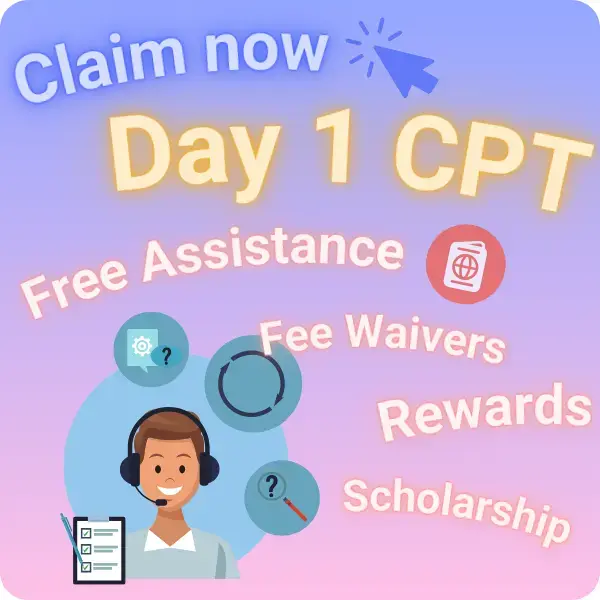
Full Day 1 CPT Universities List
Click here to view 30+ Day 1 CPT universities in different states
Scholarships & Payment Plan
Click here to explore extensive scholarships and financial aids
Get Free Assistance Now
We can help you with admission, fee waiver, and scholarships
Featured Articles
Studying and Working in the US
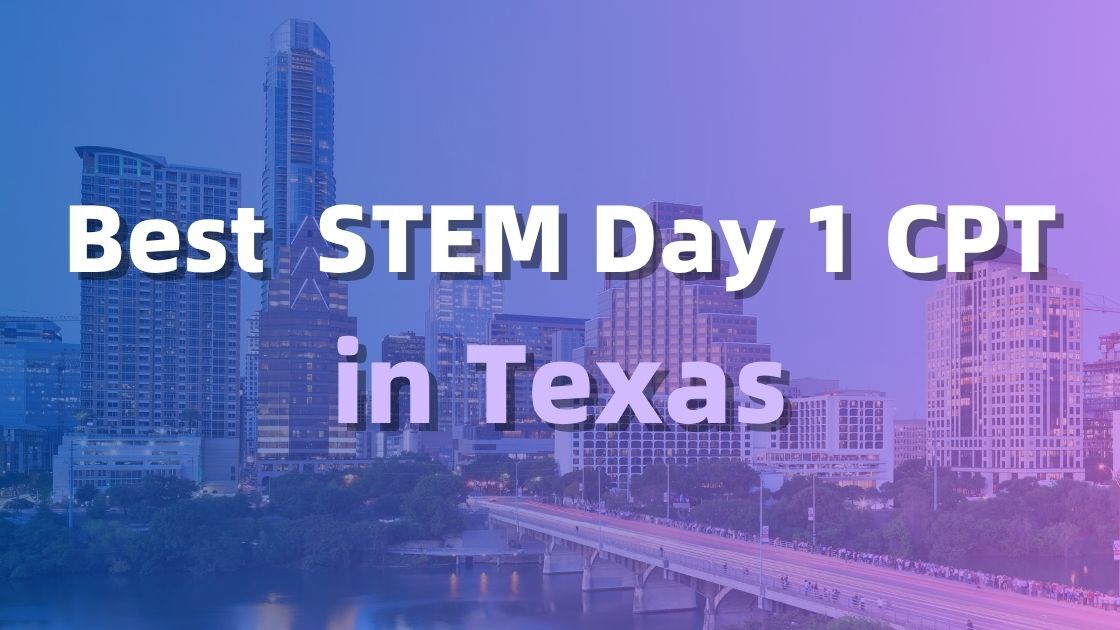
Concordia University Texas Launches New MCS Program - A Top STEM Day 1 CPT Option
-Sep-20-2025-01-14-14-5002-AM.jpg)
H-1B “$100,000 Entry Fee” Rule Explained — What It Means for F1 and OPT Students and What To Do Now

Best 5 Day 1 CPT Universities for New Yorkers
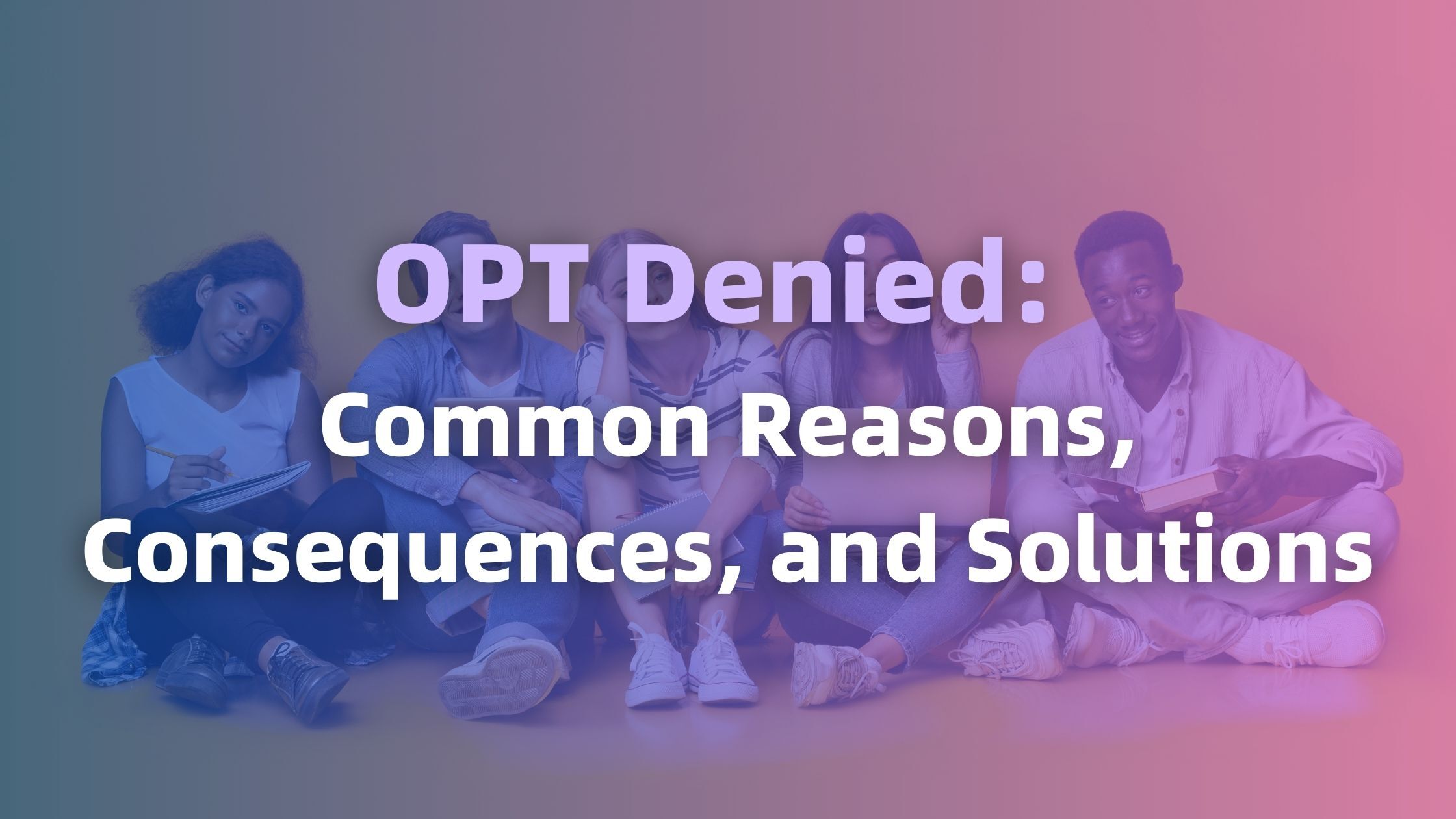
OPT Denied: Common Reasons, Consequences, and Solutions





.png?width=204&height=68&name=Verified%20(2).png)


.png?width=250&height=83&name=Logo%20-%20Rectangle%20(2).png)
.png?width=250&height=83&name=Logo%20-%20Rectangle%20(1).png)
